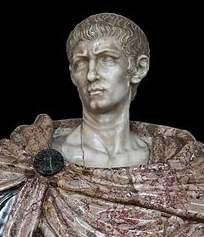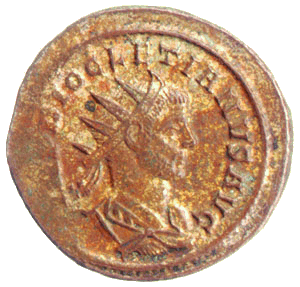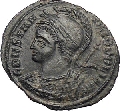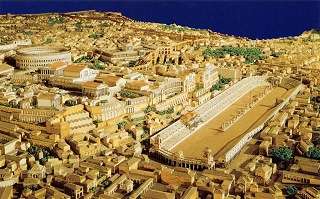
The fall of Rome and its various causes have been ripe speculation for historians of all ages. Below is excerpt from an extensive footnoted essay on the topic posted at the Cato Journal. I provide the relevant portion leading to the conclusion, but you can access the complete article here. I sure don't know if history does indeed repeat itself, but much of the hubris of the empire's leaders sounds terribly familiar to ours today.
How Excessive Government Killed Ancient Rome
By Bruce Bartlett
Emperor Diocletian's Reforms 
By the end of the third century, Rome had clearly reached a crisis. The state could no longer obtain sufficient resources even through compulsion and was forced to rely ever moreheavily on debasement of the currency to raise revenue. By the reign of Claudius II Gothicus (268-270 A.D.) the silver content of the denarius was down to just .02 percent (Michell 1947: 2). As a consequence, prices skyrocketed. A measure of Egyptian wheat, for example, which sold for seven to eight drachmaes in the second century now cost 120,000 drachmaes. This suggests an inflation of 15,000 percent during the third century.
Finally, the very survival of the state was at stake. At this point, the Emperor Diocletian (284-305 A.D.) took action. He attempted to stop the inflation with a far-reaching system of price controls on all services and commodities. These controls were justified by Diocletian's belief that the inflation was due mainly to speculation and hoarding, rather than debasement of the currency. As he stated in the preamble to his edict of 301 A.D.:
| For who is so hard and so devoid of human feeling that he cannot, or rather has not perceived, that in the commerce carried on in the markets or involved in the daily life of cities immoderate prices are so widespread that the unbridled passion for gain is lessened neither by abundant supplies nor by fruitful years; so that without a doubt men who are busied in these affairs constantly plan to control the very winds and weather from the movements of the stars, and, evil that they are, they cannot endure the watering of the fertile fields by the rains from above which bring the hope of future harvests, since they reckon it their own loss if abundance comes through the moderation of the weather. |
Despite the fact that the death penalty applied to violations of the price controls, they were a total failure. Lactantius (1984: 11), a contemporary of Diocletian's, tells us that much blood was shed over "small and cheap items" and that goods disappeared from sale. Yet, "the rise in price got much worse." Finally, "after many had met their deaths, sheer necessity led to the repeal of the law."
 Diocletian's
other reforms, however, were more successful. The cornerstone of Diocletian's
economic policy was to turn the existing ad hoc policy of requisitions to obtain
resources for the state into a regular system. Since money was worthless, the
new system was based on collecting taxes in the form of actual goods and services,
but regularized into a budget so that the state knew exactly what it needed
and taxpayers knew exactly how much they had to pay.
Diocletian's
other reforms, however, were more successful. The cornerstone of Diocletian's
economic policy was to turn the existing ad hoc policy of requisitions to obtain
resources for the state into a regular system. Since money was worthless, the
new system was based on collecting taxes in the form of actual goods and services,
but regularized into a budget so that the state knew exactly what it needed
and taxpayers knew exactly how much they had to pay.
Careful calculations were made of precisely how much grain, cloth, oil, weapons or other goods were necessary to sustain a single Roman soldier. Thus, working backwards from the state's military requirements, a calculation was made for the total amount of goods and services the state would need in a given year. On the other side of the coin, it was also necessary to calculate what the taxpayers were able to provide in terms of the necessary goods and services. This required a massive census, not only of people but of resources, especially cultivated land. Land was graded according to its productivity. As Lactantius (1984: 37) put it, "Fields were measured out clod by clod, vines and trees were counted, every kind of animal was registered, and note taken of every member of the population."
Taxable capacity was measured in terms of the caput, which stood for a single man, his family, his land and what they could produce. The state's needs were measured in terms of the annona, which represented the cost of maintaining a single soldier for a year. With these two measures calculated in precision, it was now possible to have a real budget and tax system based entirely on actual goods and services. Assessments were made and resources collected, transported and stored for state use.
Although an army on the move might still requisition goods or services when needed, the overall result of Diocletian's reform was generally positive. Taxpayers at least knew in advance what they were required to pay, rather than suffer from ad hoc confiscations. Also, the tax burden was spread more widely, instead of simply falling on the unlucky, thus lowering the burden for many Romans. At the same time, with the improved availability of resources, the state could now better plan and conduct its military operations.
In order to maintain this system where people were tied to their land, home, jobs, and places of employment, Diocletian transformed the previous ad hoc practice. Workers were organized into guilds and businesses into corporations called collegia. Both became de facto organs of the state, controlling and directing their members to work and produce for the state.
The Fall of Rome
Constantine (308-37 A.D.) continued Diocletian's policies of regimenting the economy, by tying workers and their descendants even more tightly to the land or their place of employment. For example, in 332 he issued the following order:
| Any person in whose possession a tenant that belongs to another is found not only shall restore the aforesaid tenant to his place of origin but also shall assume the capitation tax for this man for the time that he was with him. Tenants also who meditate flight may be bound with chains and reduced to a servile condition, so that by virtue of a servile condemnation they shall be compelled to fulfill the duties that befit free men. |
 Despite
such efforts, land continued to be abandoned and trade, for the most part, ceased
(Rostovtzeff 1926). Industry moved to the provinces, basically leaving Rome
as an economic empty shell; still in receipt of taxes, grain and other goods
produced in the provinces, but producing nothing itself. The mob of Rome and
the palace favorites produced nothing, yet continually demanded more,leading
to an intolerable tax burden on the productive classes.
Despite
such efforts, land continued to be abandoned and trade, for the most part, ceased
(Rostovtzeff 1926). Industry moved to the provinces, basically leaving Rome
as an economic empty shell; still in receipt of taxes, grain and other goods
produced in the provinces, but producing nothing itself. The mob of Rome and
the palace favorites produced nothing, yet continually demanded more,leading
to an intolerable tax burden on the productive classes.
In the fifty years after Diocletian the Roman tax burden roughly doubled, making it impossible for small farmers to live on their production. This is what led to the final breakdown of the economy. As Lactantius (1984: 13) put it:
| The number of recipients began to exceed the number of contributors by so much that, with farmers' resources exhausted by the enormous size of the requisitions, fields became deserted and cultivated land was turned into forest. |
 Although
Constantine made an effort to restore the currency, subsequent emperors resumed
the debasement, resulting in renewed price inflation. Apparently, Emperor Julian
(360-63 A.D.) also refused to believe that the inflation was due to debasement,
but rather was caused by merchants hoarding their stores. To prove his point,
he sent his own grain reserves into the market at Antioch. According to Gibbon
(1932: 801),
Although
Constantine made an effort to restore the currency, subsequent emperors resumed
the debasement, resulting in renewed price inflation. Apparently, Emperor Julian
(360-63 A.D.) also refused to believe that the inflation was due to debasement,
but rather was caused by merchants hoarding their stores. To prove his point,
he sent his own grain reserves into the market at Antioch. According to Gibbon
(1932: 801),
|
The consequences might have been foreseen, and were soon felt. The Imperial wheat was purchased by the rich merchants; the proprietors of land or of corn withheld from the city the accustomed supply; and the small quantities that appeared in the market were secretly sold at an advanced and illegal price. |
Although he had been warned that his policies would not lower prices, but rather would exacerbate the shortage, Julian nevertheless continued to believe that his policy worked, and blamed complaints of its failure on the ingratitude of the people.
In other respects, however, Julian was more enlightened. In the area of tax policy, he showed sensitivity and perception. He understood that the main reason for the state's fiscal problem was the excessive burden of taxation, which fell unequally on the population. The wealthy effectively were able to evade taxation through legal and illegal measures, such as bribery. By contrast, the ordinary citizen was helpless against the demands of the increasingly brutal tax collectors.
Previous measures to ease the tax burden, however, were ineffective because they only relieved the wealthy. Constantine, for example, had sought to ease the burden by reducing the number of tax units--caputs--for which a given district was responsible. In practice, this meant that only the wealthy had any reduction in their taxes. Julian, however, by cutting the tax rate, ensured that his tax reduction was realized by all the people. He also sought to broaden the tax base by abolishing some of the tax exemptions which many groups, especially the wealthy, had been granted by previous emperors.
 Nevertheless,
the revenues of the state remained inadequate to maintain the national defense.
This led to further tax increases, such as the increase in the sales tax from
1 percent to 4.5 percent in 444 A.D. However, state revenues continued to shrink,
as taxpayers invested increasing amounts of time, effort and money in tax evasion
schemes. Thus even as tax rates rose, tax revenues fell, hastening the decline
of the Roman state. In short, taxpayers evaded taxation by withdrawing from
society altogether. Large, powerful landowners, able to avoid taxation through
legal or illegal means, began to organize small communities around them. Small
landowners, crushed into bankruptcy by the heavy burden of taxation, threw themselves
at the mercy of the large landowners, signing on as tenants or even as slaves.
(Slaves, of course, paid no taxes.) The latter phenomenon was so widespread
and so injurious to the state's revenues, in fact, that in 368 A.D. Emperor
Valens declared it illegal to renounce one's liberty in order to place oneself
under the protection of a great landlord.
Nevertheless,
the revenues of the state remained inadequate to maintain the national defense.
This led to further tax increases, such as the increase in the sales tax from
1 percent to 4.5 percent in 444 A.D. However, state revenues continued to shrink,
as taxpayers invested increasing amounts of time, effort and money in tax evasion
schemes. Thus even as tax rates rose, tax revenues fell, hastening the decline
of the Roman state. In short, taxpayers evaded taxation by withdrawing from
society altogether. Large, powerful landowners, able to avoid taxation through
legal or illegal means, began to organize small communities around them. Small
landowners, crushed into bankruptcy by the heavy burden of taxation, threw themselves
at the mercy of the large landowners, signing on as tenants or even as slaves.
(Slaves, of course, paid no taxes.) The latter phenomenon was so widespread
and so injurious to the state's revenues, in fact, that in 368 A.D. Emperor
Valens declared it illegal to renounce one's liberty in order to place oneself
under the protection of a great landlord.
In the end, there was no money left to pay the army, build forts or ships, or protect the frontier. The barbarian invasions, which were the final blow to the Roman state in the fifth century, were simply the culmination of three centuries of deterioration in the fiscal capacity of the state to defend itself. Indeed, many Romans welcomed the barbarians as saviors from the onerous tax burden.
Although the fall of Rome appears as a cataclysmic event in history, for the bulk of Roman citizens it had little impact on their way of life. As Henri Pirenne (1939: 33-62) has pointed out, once the invaders effectively had displaced the Roman government they settled into governing themselves. At this point, they no longer had any incentive to pillage, but rather sought to provide peace and stability in the areas they controlled. After all, the wealthier their subjects the greater their taxpaying capacity.
In conclusion, the fall of Rome was fundamentally due to economic
deterioration resulting from excessive taxation, inflation, and over-regulation.
Higher and higher taxes failed to raise additional revenues because wealthier
taxpayers could evade such taxes while the middle class--and its taxpaying capacity--were
exterminated. Although the final demise of the Roman Empire in the West (its
Eastern half continued on as the Byzantine Empire) was an event of great historical
importance, for most Romans it was a relief.
Humanities Resource of Mark Hunter